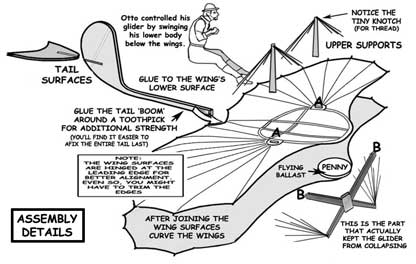
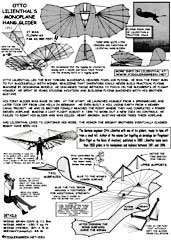
Otto Lilienthal's 1893 Pioneer monoplane Hang Glider
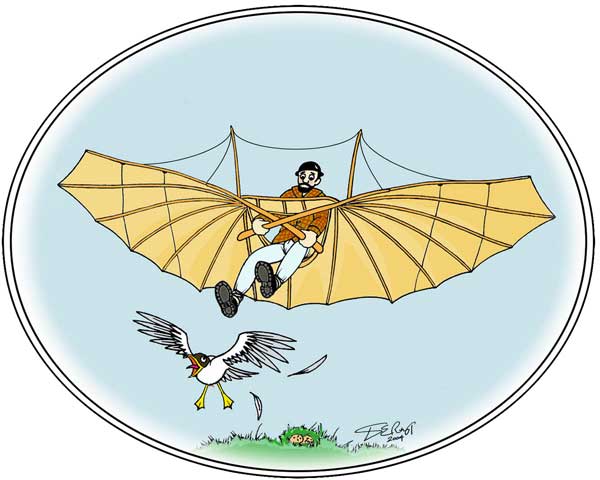
This original artwork by Derek Roberts is available in much higher quality (suitable for framing), on the Full Collection DVD.
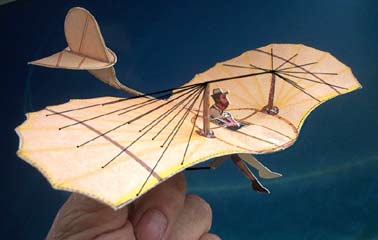 Otto Lilienthal (1848-1896) made approx 2,500 successful glides
in 1893-96, mostly in monoplane 'hang-gliders' of the type shown
with this model, During this time, incredibly, he flew distances
of up to 985 ft . Prior to this, Lilienthal had built two biplane
gliders in 1891 and 1892.
Otto Lilienthal (1848-1896) made approx 2,500 successful glides
in 1893-96, mostly in monoplane 'hang-gliders' of the type shown
with this model, During this time, incredibly, he flew distances
of up to 985 ft . Prior to this, Lilienthal had built two biplane
gliders in 1891 and 1892.
His philosophy was well summarized in his own words: 'To design
a flying machine is nothing; to build it is not much; to test
it is everything'.
This is an important model in the "Pioneer Flying Machine" series
because of the direct influence it had on the Wright Brothers.
It's also unique with a larger sized (10" span) version included
in the folder. This can be flown as a little kite in a gentle
breeze. You might want to fly from a light string with a thin
ribbon tail that's about 15" long
Otto Lilienthal's Pioneer Glider
| A Renaissance Hang Glider - Dec. 2, 2003 - A flying machine sketched by Leonardo da Vinci 500 years ago, flew gracefully last week, proving that the Renaissance genius could have made flight history long before the Wright brothers. |  |
The experiments of the German Otto Lilienthal were among the most important in aeronautical history, for they led directly to those of the Wright brothers. Although his most notable work was performed with fixed-wing gliders, Lilienthal remained mistakenly convinced that, when it arrived, the practical powered aeroplane would be an ornithopter, or wing-flapper. Some of his earliest experiments were, in fact, made with his brother Gustav on quite large ornithopters, but these were interrupted first by his service in the Franco-Prussian War and then by his profession of civil engineering.
In 1889 Otto Lilienthal published a book having the English title Bird Flight as the Basis of Aviation, wherein he studied the forms and anatomy of birds' wings and the application of data learned from them to the achievement of human flight. Some of his findings were later proved by the Wright brothers to be incorrect, but the book remains as one of the great classics of aeronautical literature.
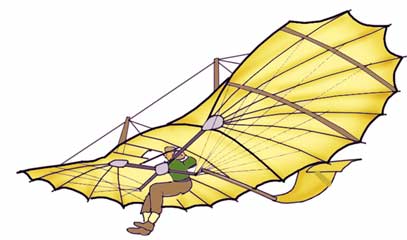 In
order to gain practical experience before returning to his work on ornithopters,
Lilienthal built his first fixed-wing glider in 1891, and between that year
and 1896 constructed five types of monoplane glider and two biplane types. His
first means of launching was a spring-board, but this he soon abandoned in favor
of hill launching. Some of his tests were made from the Rhinower Hills, near
Stollen, but he also had constructed an artificial hill near Berlin.
In
order to gain practical experience before returning to his work on ornithopters,
Lilienthal built his first fixed-wing glider in 1891, and between that year
and 1896 constructed five types of monoplane glider and two biplane types. His
first means of launching was a spring-board, but this he soon abandoned in favor
of hill launching. Some of his tests were made from the Rhinower Hills, near
Stollen, but he also had constructed an artificial hill near Berlin.
Lilienthal supported himself in his gliders by his arms, so that after a running take-off his hips and legs dangled below the aircraft, allowing him to swing his body in any desired direction to achieve stability and control. After 1893 he was achieving glides of 300-750 ft, with remarkable ease of control.
In 1895 he was developing a type of body harness to work a rear elevator. The purpose of this was to give better control in rising or descending by increasing the effect of the occupant swinging his body forwards or backwards and thus altering the center of gravity. Lilienthal also tested a glider which had flapping wing-tips, driven by a small carbonic acid gas engine. This system could never have equaled in efficiency the new petrol engines and propellers which were soon to come into being; but the great German inventor/ pilot was never to become aware of this, for he crashed in one of his gliders in the Rhinower Hills on 9 August 1896, and died in a Berlin clinic on the following day. His last words were 'Opfer mussen gebracht werden' ('Sacrifices must be made').
Little known before Lilienthal's death was the practical help he had given to a young Englishman named Percy Pitcher, who paid him two visits. In 1893 Pitcher had been appointed assistant lecturer in Naval Architecture and Marine Engineering at Glasgow University, and it was there that he designed his first glider, the Bat. This was uncompleted at the time of his first visit to Lilienthal in 1895. On his second visit, in the following year, he made his first glides, under Lilienthal's' tuition, and back again in Britain he tested and redesigned the Bat and built other gliders. In May 1899 he presided at a lecture given by the Australian Lawrence Hargrave on soaring kites, in the development of which Hargrave was pre-eminent. Pitcher then built a triplane glider embodying Hargrave's ideas, but before he could test this he crashed in the Hawk of his own design and died on 2 October 1899. Pitcher was the first Englishman to lose his life in a heavier than-air flying machine.
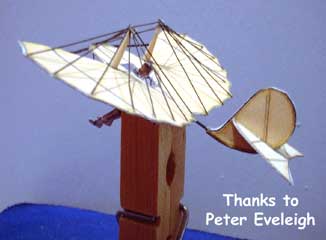 Peter gets cheers for his intricate work. Look at that tiny rigging! Thanks for sending in the photo Peter. |
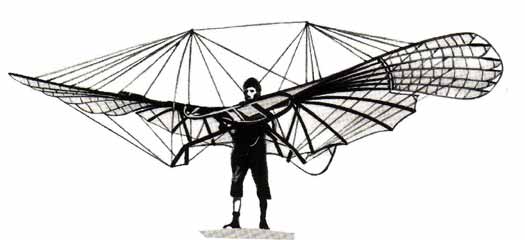 An early pen sketch of Otto's Hang Glider and how he fit into it |
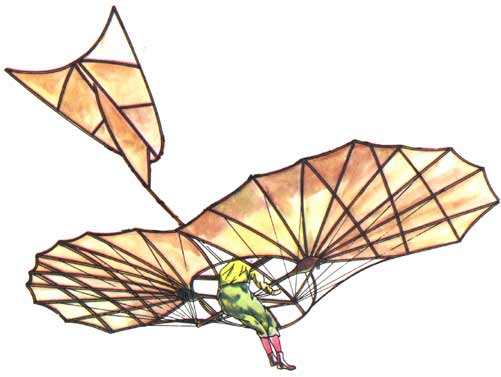 Otto Lilienthal just after launching.The name of Lilienthal stands as the greatest in the history of practical flying before the Wright brothers. Perhaps the finest monuments to Lilienthal are the gliding clubs throughout the world which give such pleasant recreation to men and women at little cost. |
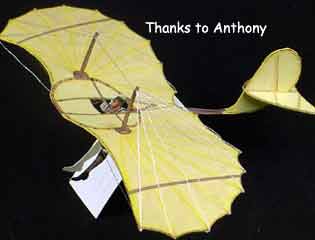 Anthony, on the other hand has always been a wonderful customer of Fiddlers Green and we're displaying many of his models on the site. Note he made a little stand to display his Otto. |
Specifications for Otto Lilienthal's Glider
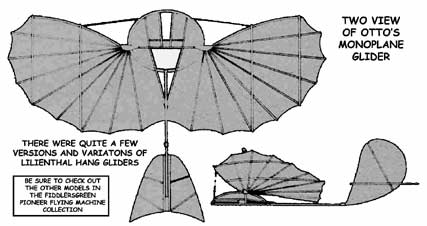 |
Wing Span: 22 ft 11.5 in |



